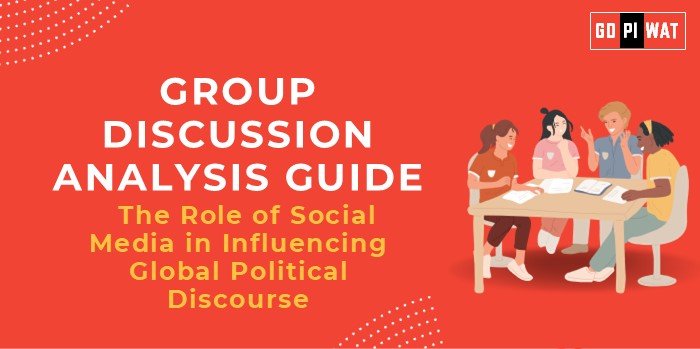📋 Group Discussion (GD) Analysis Guide
🌐 The Role of Social Media in Influencing Global Political Discourse
🌟 Introduction
Social media has emerged as a cornerstone of modern political discourse, influencing electoral campaigns, protests, and public opinion on a global scale. Platforms like Facebook, Twitter, and TikTok have become tools for mobilization, advocacy, and even disinformation. Their role in shaping political narratives continues to grow as global connectivity expands.
📊 Quick Facts & Key Statistics
- 🌍 Global Social Media Users: 5.22 billion (63.8% of the global population as of October 2024).
- 💸 Election Spending on Digital Ads: Over $619 million in the U.S. 2024 election cycle.
- ✊ Role in Protests: Platforms like Facebook and Twitter have been pivotal in organizing movements like the Arab Spring and Black Lives Matter.
- ⚠️ Disinformation: False news spreads faster than verified information, often shaping electoral outcomes and public sentiment.
- ⏱️ Engagement Metrics: The average user spends 2 hours and 27 minutes daily on social media platforms.
👥 Stakeholders and Their Roles
- Governments: Use platforms for public engagement, policy dissemination, and monitoring.
- Citizens: Leverage social media for advocacy, information sharing, and mobilization.
- Tech Companies: Design algorithms, moderate content, and influence platform policies.
- NGOs/Advocacy Groups: Drive awareness campaigns and influence policymaking.
- Media Outlets: Amplify political debates initiated on social platforms.
🎯 Achievements and Challenges
- Achievements:
- 📢 Mass Mobilization: Social media enabled global protests, such as the Black Lives Matter movement, to gain international momentum.
- 🗳️ Increased Political Awareness: Social media campaigns have raised voter turnout among younger demographics.
- 🌎 Global Dialogue: Minority and marginalized voices have gained visibility through platforms.
- Challenges:
- ⚠️ Disinformation: False narratives have disrupted elections and policy debates.
- 💬 Polarization: Algorithms create echo chambers, exacerbating societal divisions.
- 🔐 Cybersecurity Concerns: Accounts of political entities and movements remain vulnerable to hacking.
- Global Comparisons:
- ✔️ Success: Estonia uses social media to foster transparent e-governance.
- ❌ Failure: Myanmar’s Rohingya crisis was exacerbated by unchecked hate speech on Facebook.
💡 Effective Discussion Approaches
- Opening Techniques:
- Start with data: “With 5.22 billion users, social media influences two-thirds of the world’s population.”
- Case study reference: Highlight the role of Twitter in movements like Black Lives Matter.
- Counter-Argument Handling:
- Present solutions like AI moderation to tackle misinformation.
- Discuss the need for public-private partnerships to ensure ethical practices.
📈 Strategic Analysis of Strengths & Weaknesses
- Strengths: Rapid information dissemination, global reach, and real-time communication.
- Weaknesses: Lack of robust content regulation, susceptibility to misuse.
- Opportunities: Enhanced algorithm transparency, collaboration with governments for ethical use.
- Threats: Increased political censorship, cyber-attacks targeting electoral campaigns.
⚖️ Structured Arguments for Discussion
- Supporting Stance: “Social media is democratizing access to political discourse, empowering marginalized communities.”
- Opposing Stance: “Unregulated social media is a breeding ground for misinformation and polarization.”
- Balanced Perspective: “While social media is a tool for political engagement, its unchecked misuse poses significant risks.”
📚 Connecting with B-School Applications
- Real-World Applications: Studies on the impact of digital marketing strategies in political campaigns.
- Sample Interview Questions:
- “How can social media be effectively regulated without stifling free speech?”
- “Discuss a global protest movement that successfully utilized social media.”
- Insights:
- Understanding the role of social media analytics in decision-making.
- Balancing ethical considerations in digital communication strategies.


